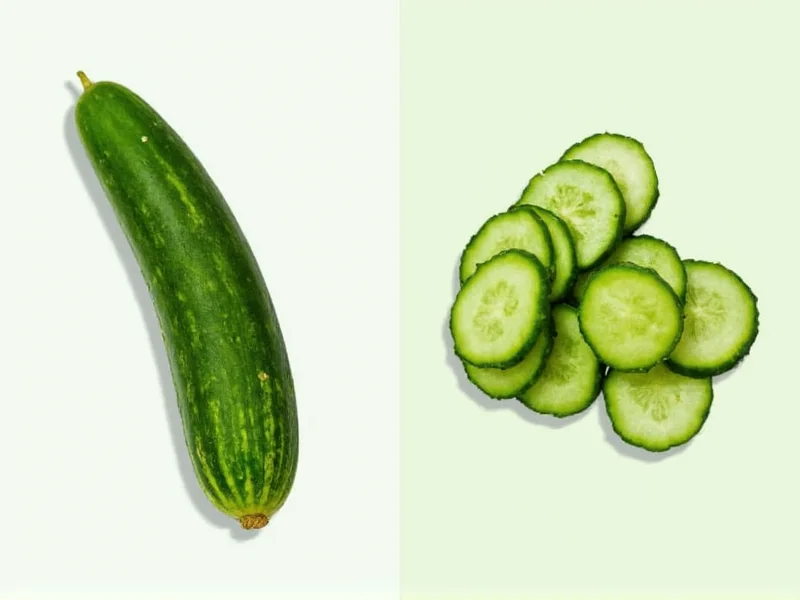When exploring the difference between cucumber and pickle, it's essential to understand their biological and culinary relationship. Cucumbers belong to the Cucurbitaceae family and grow as fresh produce on vines. Pickles, conversely, don't exist as a separate plant species—they're cucumbers transformed through preservation. This distinction between fresh cucumber versus pickled cucumber forms the foundation of our comprehensive comparison.
Botanical Identity: What Makes a Cucumber a Cucumber
Cucumbers (Cucumis sativus) are annual climbing plants producing elongated, cylindrical fruits with thin green skin and high water content (approximately 95%). They grow on sprawling vines and belong to the same plant family as melons and squash. Commercially, two main varieties exist:
- Slicing cucumbers - Larger, smooth-skinned varieties eaten fresh (like the common "English" or "burpless" cucumbers)
- Pickling cucumbers - Smaller, bumpier varieties specifically bred for preservation (such as Kirby cucumbers)
The difference between regular cucumber and pickle-ready cucumber lies in their physical characteristics. Pickling varieties typically have thicker skins, less seed space, and a firmer texture that withstands the preservation process better than slicing varieties.
The Transformation: How Cucumbers Become Pickles
Pickling represents a food preservation method that transforms cucumbers through either:
- Fermentation pickling - Submerging cucumbers in saltwater brine, allowing natural bacteria to produce lactic acid (traditional method)
- Vinegar pickling - Immersing cucumbers in vinegar solution with added spices (faster modern method)
This chemical transformation fundamentally alters the cucumber's properties. The difference between fresh cucumber and pickle becomes evident through:
- Acidification (pH drops from ~5.12-5.78 in cucumbers to ~3.2-3.6 in pickles)
- Texture changes (increased firmness from calcium chloride or tannins)
- Flavor development (sourness from acetic or lactic acid)
- Nutritional modification (reduced vitamin C, increased sodium)
Comparing Cucumber vs Pickle: Key Differences
| Characteristic | Cucumber | Pickle |
|---|---|---|
| Nature | Fresh vegetable | Preserved food product |
| Shelf Life | 7-10 days refrigerated | 1-2 years unopened, 2-4 months after opening |
| Primary Preservation | None (fresh) | Vinegar or fermentation brine |
| Flavor Profile | Mild, slightly sweet, watery | Tangy, sour, often spiced |
| Nutritional Difference | Low sodium (2mg/100g), higher vitamin K | High sodium (1,000-1,500mg/100g), lower vitamins |
| Botanical Classification | Cucumis sativus (living plant) | No botanical classification (processed food) |
Common Misconceptions About Cucumbers and Pickles
Several misunderstandings persist regarding the difference between cucumber and pickle:
Misconception 1: Pickles are a different vegetable
Reality: Pickles aren't a separate plant species—they're exclusively processed cucumbers. The term "pickle" refers to the preservation method, not a distinct vegetable.
Misconception 2: All cucumbers make good pickles
Reality: While technically possible, commercial pickle production uses specific varieties. The difference between regular cucumber and pickle cucumber matters—Kirby varieties have the ideal density and skin thickness for proper pickling.
Misconception 3: Gherkins are a different species
Reality: Gherkins (West Indian or burr cucumbers) are actually a different species (Cucumis anguria) but are often confused with small pickling cucumbers. Most "gherkin" pickles sold commercially are actually made from small Kirby cucumbers.
Nutritional Comparison: Health Implications
Understanding the nutritional difference between cucumber and pickle is crucial for dietary considerations:
A 100g serving comparison reveals significant changes:
- Sodium content increases from 2mg in cucumbers to 1,000-1,500mg in pickles
- Vitamin C decreases from 2.8mg to nearly zero due to acid processing
- Probiotics develop in fermented pickles (not vinegar-brined)
- Caloric content remains similar (15kcal for cucumbers vs 11kcal for pickles)
The preservation process fundamentally alters the food's properties. While cucumbers offer hydration and fresh nutrients, pickles provide probiotic benefits (in fermented varieties) but with significantly higher sodium content—a critical difference between fresh cucumber and pickle for health-conscious consumers.
Practical Applications: When to Use Each
The culinary difference between cucumber and pickle determines their appropriate uses:
Cucumbers shine in:
- Fresh salads and sandwiches
- Cold soups like gazpacho
- Hydrating snacks and smoothies
- Skin care applications (due to high water content)
Pickles excel in:
- Adding tangy contrast to rich foods (burgers, sandwiches)
- Providing probiotic benefits (fermented varieties)
- Long-term food preservation
- Creating distinctive flavor profiles in cooked dishes
Professional chefs understand that substituting one for the other rarely works—the difference between cucumber and pickle in cooking stems from their fundamentally different textures and flavor profiles. Pickles' acidity cuts through richness, while cucumbers provide refreshing coolness.
Making the Transformation at Home
Creating your own pickles reveals the dramatic difference between cucumber and pickle. The basic process involves:
- Selecting firm, unwaxed cucumbers (preferably pickling varieties)
- Preparing a brine (50-50 water-vinegar ratio with 2-3 tablespoons salt per quart)
- Adding flavorings (dill, garlic, mustard seeds, peppercorns)
- Processing in a water bath or refrigerating for quick pickles
Within 24-72 hours, the transformation becomes evident—the crisp cucumber develops that characteristic pickle tang and firmer texture. This hands-on experience perfectly illustrates the difference between fresh cucumber versus pickled cucumber.











 浙公网安备
33010002000092号
浙公网安备
33010002000092号 浙B2-20120091-4
浙B2-20120091-4